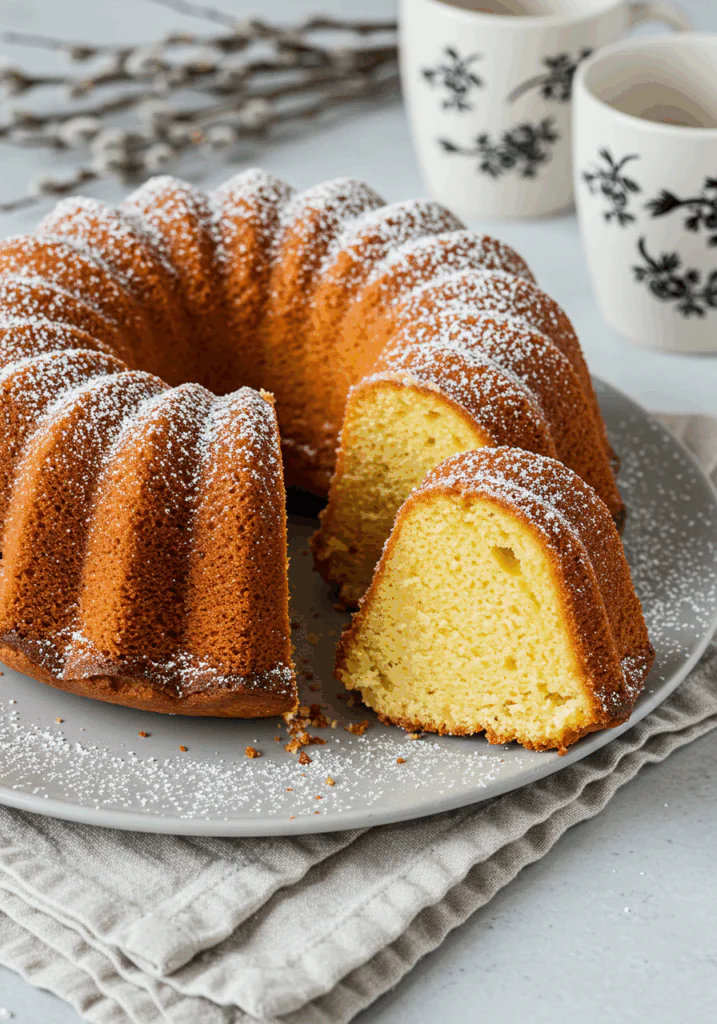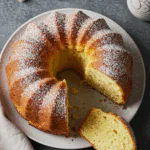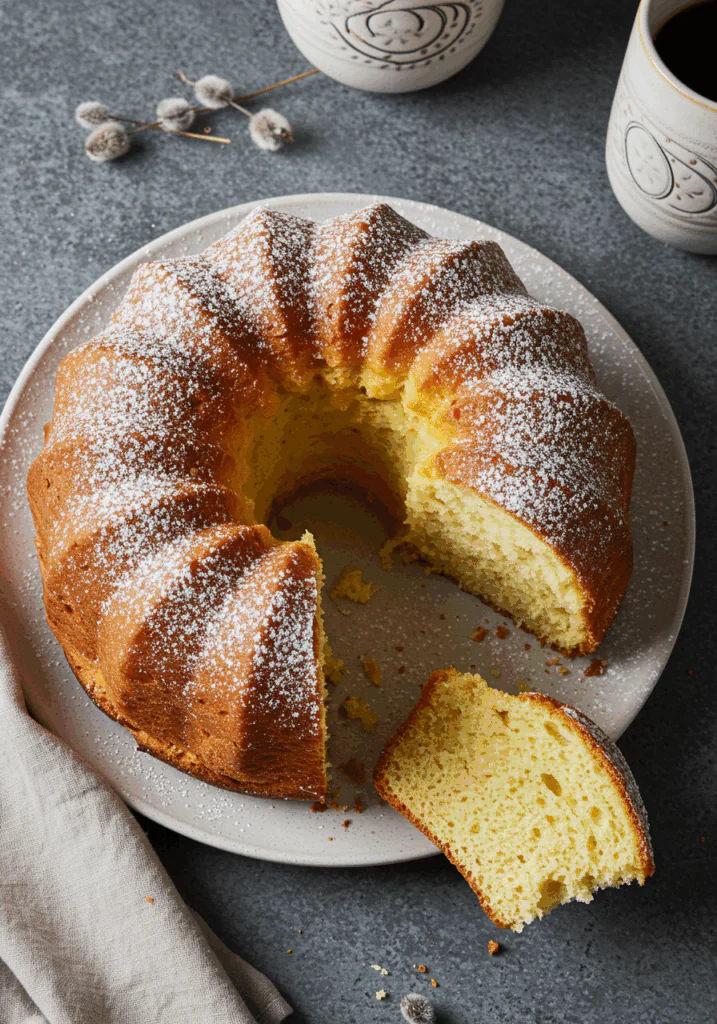Light, fluffy, and delicately sweet, this Portuguese Easter Cake (Pão de Ló) is a timeless celebration dessert with centuries of tradition. Often served during Easter in Portugal, this sponge cake is known for its airy texture, golden color, and rich egg flavor. Made with just a few ingredients, it rises beautifully without baking powder and tastes divine with a dusting of powdered sugar or a drizzle of honey.
Want recipes like this delivered straight to your inbox? Subscribe now to get the latest culinary creations you’ll love.
Why You’ll Love This Recipe
Old-World Charm – A simple, authentic cake with deep cultural roots.
Ultra Fluffy Texture – Achieved through whipped eggs—no leaveners needed.
Minimal Ingredients – Just eggs, sugar, and flour.
Perfect for Celebrations – Especially Easter, but great year-round.
Customizable – Serve plain or with fruit, whipped cream, or jam.
Ingredients You’ll Need
- 6 large eggs, room temperature
- 1 cup granulated sugar
- 1 cup all-purpose flour, sifted
- 1 tsp vanilla extract (optional)
- Zest of 1 lemon (optional for added fragrance)
Tools You’ll Need
- Stand mixer or hand mixer
- Mixing bowls
- 9-inch round cake pan or springform pan
- Parchment paper
- Fine mesh sifter
- Rubber spatula
Step-by-Step Instructions
Step 1: Prepare Your Pan
Preheat oven to 350°F (175°C).
Line your cake pan with parchment paper—bottom and sides. Allow excess paper to rise above the edge to help the cake hold shape.
Do not grease the pan, as this helps the cake climb and stay airy.
Step 2: Whip the Eggs and Sugar
In a large mixing bowl, beat eggs and sugar on high speed for 10–12 minutes until the mixture is pale, thick, and triples in volume.
It should form ribbons when you lift the beater.
Step 3: Add Vanilla and Lemon Zest (Optional)
Fold in the vanilla and lemon zest gently, being careful not to deflate the batter.
Step 4: Incorporate the Flour
Sift the flour over the egg mixture in 2–3 additions.
Using a rubber spatula, gently fold in the flour after each addition.
Fold carefully to keep the batter airy—don’t overmix.
Step 5: Bake the Cake
Pour the batter into the prepared pan.
Bake for 30–35 minutes until the top is golden and a toothpick inserted comes out with a few moist crumbs.
Avoid opening the oven door in the first 25 minutes to prevent collapse.
Step 6: Cool & Serve
Let the cake cool in the pan for 10 minutes, then lift it out using the parchment and place on a wire rack.
Cool completely before slicing.
Serve as-is or dust with powdered sugar for an elegant touch.

Tips for the Best Pão de Ló
Room Temperature Eggs – They whip up with more volume and structure.
Beat Thoroughly – The egg-sugar mixture must be light and fluffy before folding in flour.
Sift the Flour – Prevents clumps and keeps the batter smooth.
Don’t Overbake – The center should be just set for a moist texture.
Cool Upside Down – This prevents the cake from sinking too much in the middle.
Serving Suggestions
Dust with Powdered Sugar – A traditional finish.
Drizzle with Honey – Adds richness and shine.
Serve with Berries – Raspberries or strawberries complement it perfectly.
Whipped Cream or Yogurt – For a creamy contrast.
Espresso or Tea – Ideal for a light dessert pairing.
How to Store & Reheat
Storing:
- Room Temperature: Store covered for up to 2 days.
- Refrigerator: Lasts up to 5 days, though texture is best within the first 2 days.
Freezing:
- Wrap slices tightly in plastic wrap and foil. Freeze for up to 2 months.
- Thaw at room temperature before serving.
Reheating:
- Not typically needed—best served at room temperature.
Frequently Asked Questions
1. Is Pão de Ló supposed to be dry or moist?
It varies by region! Some versions are firmer and sponge-like, while others (like Pão de Ló de Ovar) are very moist and even slightly runny in the center.
2. Can I add baking powder?
Traditionally no, as the lift comes entirely from whipped eggs. Proper beating is key.
3. Can I use a bundt pan?
A round or springform pan works best. A bundt pan may alter the rise and texture.
4. Is this cake very sweet?
No—it’s lightly sweet, making it ideal for pairing with sweet toppings or coffee.
5. Can I use gluten-free flour?
Yes, use a 1:1 gluten-free blend for best results. Avoid overmixing to preserve airiness.
Final Thoughts
This Portuguese Easter Cake (Pão de Ló) is a simple yet elegant dessert that celebrates tradition and the beauty of baking with just a few ingredients. Whether you enjoy it plain or dressed up, its light and fluffy texture is truly unforgettable.
Bake it this Easter or anytime you want something subtly sweet and special. And if you share your slice online, don’t forget to tag your creation—I’d love to see it!
Preparation Time: 15 minutes
Baking Time: 35 minutes
Cuisine: Portuguese
Nutritional Information (Per Serving):
Calories: 180 | Protein: 4g | Carbohydrates: 28g | Fat: 5g | Fiber: 0g | Sugar: 18g | Sodium: 30mg

Portuguese Easter Cake (Pão de Ló)
- Total Time: 50 minutes
Description
Light, fluffy, and delicately sweet, this Portuguese Easter Cake (Pão de Ló) is a timeless celebration dessert with centuries of tradition. Often served during Easter in Portugal, this sponge cake is known for its airy texture, golden color, and rich egg flavor. Made with just a few ingredients, it rises beautifully without baking powder and tastes divine with a dusting of powdered sugar or a drizzle of honey.
Want recipes like this delivered straight to your inbox? Subscribe now to get the latest culinary creations you’ll love.
Ingredients
Ingredients You’ll Need
-
6 large eggs, room temperature
-
1 cup granulated sugar
-
1 cup all-purpose flour, sifted
-
1 tsp vanilla extract (optional)
-
Zest of 1 lemon (optional for added fragrance)
Instructions
Step 1: Prepare Your Pan
Preheat oven to 350°F (175°C).
Line your cake pan with parchment paper—bottom and sides. Allow excess paper to rise above the edge to help the cake hold shape.
Do not grease the pan, as this helps the cake climb and stay airy.
Step 2: Whip the Eggs and Sugar
In a large mixing bowl, beat eggs and sugar on high speed for 10–12 minutes until the mixture is pale, thick, and triples in volume.
It should form ribbons when you lift the beater.
Step 3: Add Vanilla and Lemon Zest (Optional)
Fold in the vanilla and lemon zest gently, being careful not to deflate the batter.
Step 4: Incorporate the Flour
Sift the flour over the egg mixture in 2–3 additions.
Using a rubber spatula, gently fold in the flour after each addition.
Fold carefully to keep the batter airy—don’t overmix.
Step 5: Bake the Cake
Pour the batter into the prepared pan.
Bake for 30–35 minutes until the top is golden and a toothpick inserted comes out with a few moist crumbs.
Avoid opening the oven door in the first 25 minutes to prevent collapse.
Step 6: Cool & Serve
Let the cake cool in the pan for 10 minutes, then lift it out using the parchment and place on a wire rack.
Cool completely before slicing.
Serve as-is or dust with powdered sugar for an elegant touch.
Notes
Room Temperature Eggs – They whip up with more volume and structure.
Beat Thoroughly – The egg-sugar mixture must be light and fluffy before folding in flour.
Sift the Flour – Prevents clumps and keeps the batter smooth.
Don’t Overbake – The center should be just set for a moist texture.
Cool Upside Down – This prevents the cake from sinking too much in the middle.
- Prep Time: 15 minutes
- Cook Time: 35 minutes
- Cuisine: Portuguese



